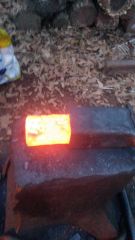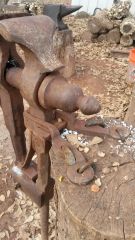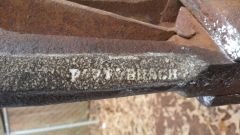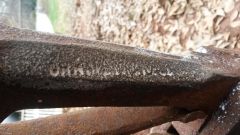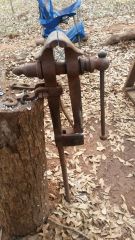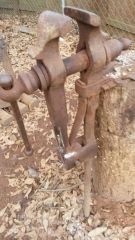-
Posts
1,638 -
Joined
-
Last visited
Content Type
Profiles
Forums
Articles
Gallery
Downloads
Events
Everything posted by Nobody Special
-
Welcome to IFI. There's an Alex Bealer group meet in Atlanta on the 18th if you're interested. Not sure how "central" Georgia you are, but someone there might be able to point you in the right direction. Be patient. It seems like nothing...nothing...nothing out there, then all of a sudden you have to pick between three sweet deals.
-
So, there was a wonderful link in a forum that Gergely posted on here recently to the American Natural History museum's african collection of ethnography. Well worth a look if you haven't already. But while I was looking around other parts of their site, I ran into pictures of something that was a little different from some of the smelting that I'd seen while looking around the web. It's called a pit or bowl furnace, from what I can find was apparantly used to make blooms prior to beehive furnaces or furnaces with a shaft. I've seen similar ones for smelting copper, but not iron. Apparantly you dig a shallow pit, about a foot and a half across and same depth, build your fire, then charge alternating roasted and crushed ore with charcoal as normal. Next apply bellows through clay tuyeres and go to town. This site said they made a bloom in about an hour, which I'm not sure I believe, and I found other accounts that said around ten hours, which sounds more like. I'm also not sure how this particular tribe arranged to tap slag, although I've found other ones that used pits, channels etc. If anyone has any more info or sources on this kind of bloom furnace, I'd love to hear it. Below are some of the pics. I have not included direct links to the pictures because there is partial nudity on some of them in the site in a National Geographic sort of way.
-
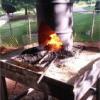
Rust blooms on carbon steel kitchen knife
Nobody Special replied to Swords9023's topic in Knife Making
On my carbon steel kitchen knives, (most of which I got and treasured years before I started any kind of forging), I find it helps to clean, dry and oil immediately after use. That goes double with an acidic food like lemons or tomatoes. No dishwashers, and no leaving 'em in/near the sink. Another thing that seems to help is don't toss them in a drawer with a bunch of other knives. They rust faster, and get dull faster. Better to get a knife block or magnetic strip.- 11 replies
-
- rivet
- apprentice
-
(and 8 more)
Tagged with:
-
I put a little bit of a taper where the peen will be, and it's lightly wedged into the square tubing to keep it from rolling while I'm punching. No hardy on my anvil since the heel's broken off, and I got tired of it moving on me. The tubing's just sitting there, no attachments, but between it and holding the punch in one hand, I had a lot more control. With smaller stock I could ding the tubing in a little for a smaller diameter. Theres a forum for it under shop tricks.
-
'>
-
Not me, 13 degrees and wind chill -4, and still dropping. Not cheesehead land cold, but not bad for Georgia. I split some more pecan wood for the wife for about an hour and decided firmly against forging tonight. If I can't get warm swinging a maul, I ain't staying out.
-
Well, Google ain't perfect, but Google and Wikipedia can give you a headstart....... The Guelph Civic museum gives you the name of a bunch of foundrys in the area, and a lot of cool documents if you search their collections. Found one wooden anvil casting pattern that looks a little similar to yours, but that beat up, hard to say for sure. There's also contact numbers if you wanted to call them to help you out. http://guelph.ca/museum/?page_id=377 The big ones for the area (although) it looks like there was at least around 10 founders for the area were Callandar Foundry and Manufacturing Company Ltd., Wellington Foundry (or Wellington Mills), Mills and Melvin Iron Founders (at some point also Mills and Goodfellow Foundry) and Robertson Foundry. Callandar looks like it was mostly cast iron wood working tools, saws, drill presses, that kind of thing until it was bought out by Rockwell pre-WWII, Wellington made farm implements, and Mr A. Robertson apparantly did all kinds of general castings, and during the American civil war was heavily involved in making cast iron munitions/weapons for the South! Google will find you all kinds of old advertisements, town histories, etc..... NTK, you may not find everything on the internet, but it's still a fun journey, and the info and pics on the sidetrips and dead ends are fascinating......
-

Sources of Knowledge about Historical African Blades
Nobody Special replied to Gergely's topic in Historical Blades
Well, now you've given me something to keep me completely distracted during the slow bits at work.....you had me at the first knife to pop up, some kind of throwing knife/skinner? from Gabon. I love the different "flavors" of knife making they have, styles and angles, decor, carving on the knives and the sheathes (again one of the first couple pages had a bizarre looking 3 bladed throwing knife, some that look like shoehorns, or the handle is a tiny tang with a vegetable fiber wrapping). Contrast with some that show influences from ancient Europe, Persia, etc. A few that strongly resemble old Egyptian daggers, Roman gladiuseseses......gladii?, billhooks, arabic styles of knives, (in non-arabic African countries) and so on. It ain't Africa, but I've run into similar problems with Texas. People don't realize Texarkana is closer to New York than El Paso, and I don't even want to be reminded of all the times I've been overseas and had people ask me, in deadly earnest if I rode a horse to work. Or stateside heard "Oh, my son's in the army too, he's stationed at ........ Do you know him?" -
Made hoppin' john for the new year. Watched Lord of the Rings with the kids. Picked up a big crosspein hammer I'd started and worked on it for awhile.
-
I was working on a hammer out of some two inch stock from an axle today, working by myself, and just couldn't manage to keep the stock in the right position. My anvil's missing the heel, so no hold down in the pritchel or hardy. And of course every time I'd try to hit the punch against the stock it would roll, even after putting a bit of a flat on one side. So.....I put a little bit of a taper on one end where the peen is gonna go, and wedged the tapered end into a piece of square tubing. It worked a lot better, and if I was working something a different size, I think I could just bend the tubing to fit. I suppose you could work it in the vise.....but this seemed like a good idea and thought I'd share. Feel free to criticize or add your own ideas. When I finish the hammer, I'll post pics. Ya'll could probably use a good laugh after the holidays. http://www.iforgeiron.com/gallery/image/37948-square-hold-down/
-
-

William Foster, Broken Horn, 1834
Nobody Special replied to fordmustangbrad's topic in Anvils, Swage Blocks, and Mandrels
Nice find! I have an 1816 William Foster missing the opposite end I picked up for 75. Hope yours is as good as mine, it has as good a rebound as I've found, and is a pleasure to work on, not bad for 200 yrs old. Seems like a lot of anvils in this brand is broken on one end or the other. Makes for a great bargain. Is that an anchor I see stamped on the side? Mine has one too. I was told it "may" mean that it was used in the Royal Navy. Good forging to ya in the new year! -
Happy 2014!!! Hmmm.... do I smell like gunpowder from fireworks or from coal?
-

Show us your blacksmithing Christmas swag!
Nobody Special replied to Karn3's topic in Blacksmithing, General Discussion
Got a new angle grinder, and some scrap iron. :D -
You'll never guess it from the title, but I've got a post vise that I can't identify, and I thought one of ya'll might enjoy the challenge and be able to tell me who made it and when-ish. About 45 lbs I think, 4 inch jaws. Mystery markings on one leg appears to say "peter beach" or something similar, the other I can't make out even after rubbing with confectioners sugar (we're out of flour, it's the holidays, don't ask.) Maybe it's a partial Frankenstein's monster? I dunno. Definitely unsure about all the washers behind on one end, but one of my cardinal rules with machinery is if ya buy it, and it works well, clean it up, but don't reconfigure it. It had been sitting on the ground out in the elements for about 15 yrs when I picked it up, and with a little cleaning and grease, works well. (I will probably clean the grease out of the threads and change it for wax or something later so it doesn't pick up filings etc.) Since I work outside, may hit it with the wire brush and paint it black too. I know it breaks with tradition, especially the "watch out for paint hiding flaws" rule, but I like this thing and want it to last. Anyways, thanks for the help! Nbs http://www.iforgeiron.com/gallery/image/37923-pv5/ http://www.iforgeiron.com/gallery/image/37922-pv4/ http://www.iforgeiron.com/gallery/image/37921-pv3/ http://www.iforgeiron.com/gallery/image/37920-pv2/ http://www.iforgeiron.com/gallery/image/37919-pv1/
- 2 replies
-
- great mystery
- conundrum
-
(and 1 more)
Tagged with:
-
One I don't see mentioned as much is rings. I've seen gloves rip a guy's fingers almost off on a lathe, but if something gets ahold of a wedding band, or in between it and the finger, it's Ugly.............
-

Great Rivet Collection
Nobody Special replied to divermike's topic in Blacksmithing, General Discussion
Nice catch. I swear though, if you told me 10 yrs ago that some day I'd be jealous of another man's rivet collection......... -

Making a mold
Nobody Special replied to greybard1's topic in Smelting, Melting, Foundry, and Casting
Ewe, baa...d joke. Of course, it has to be a cable knit.........

